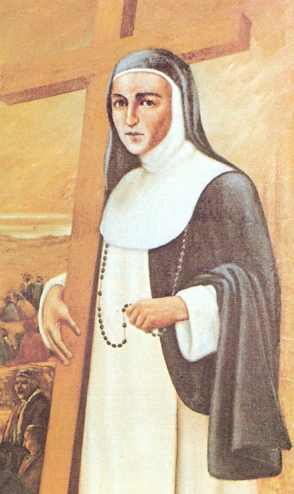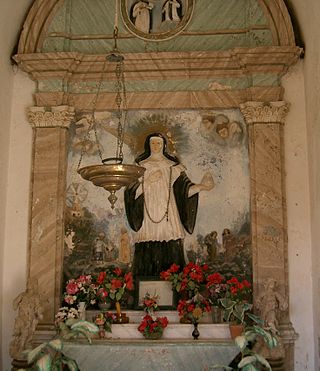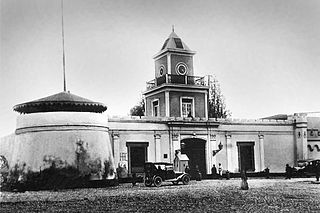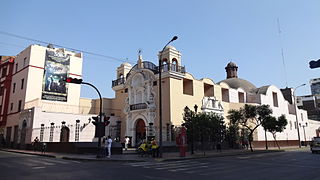
Rose of Lima, TOSD was a member of the Third Order of Saint Dominic in Lima, Peru, Spanish Empire, who became known for both her life of severe penance and her care of the poverty stricken of the city through her own private efforts.

The Monastery of Santa Catalina de Siena is a large monastery of the Dominican Second Order, located in Arequipa, Peru.

La Victoria is one of the forty-three districts that make up the province of Lima, located in Peru. It borders to the north and northeast with the district of Lima, to the east with the district of San Luis, to the southeast with the district of San Borja, to the south with the district of San Isidro, and to the west with the district of Lince and again with the Lima district. La Victoria is a historical and very busy public district located in downtown Lima. The current mayor of La Victoria is Rubén Dioscorides Andrés Cano Altez.

Ana Monteagudo Ponce de Leon, OP, also known as Anaof the Angels Monteagudo, was a Peruvian Catholic nun from the Dominicans.

The Seminary of Saint Turibius, also known as the Seminary of Lima or, is a priestly seminary in charge of training seminarians to be future priests of the Roman Catholic Archdiocese of Lima. It is based in Lima, Peru, and is the second oldest seminary in the Americas after that of Bogotá, having been founded on December 7, 1591, by then Archbishop Turibius of Mongrovejo.

Jerónima de la Asunción, O.S.C. was a Spanish Catholic nun and abbess who founded the Real Monasterio de Santa Clara in Intramuros, Manila, Philippines.

The Lord of Miracles, also known as " Christ of Miracles", is a Roman Catholic title of Jesus Christ that is associated with a painting of Christ crucified venerated in Lima, Peru. The image was painted during the 17th century by Benito or Pedro Dalcon, an African taken from what is now Angola to Peru as a slave. An annual procession commemorating the image occurs every October. It is one of the oldest Catholic traditions in Peru. It is one of the largest religious processions in the world.

Francisca del Espíritu Santo de Fuentes was a Spanish Roman Catholic religious sister. She became the first prioress of the Congregation of the Dominican Sisters of St. Catherine of Siena in the Philippines.

The Real Monasterio de la Encarnación is a convent of the order of Recollet Augustines located in Madrid, Spain. The institution mainly interned women from noble families, and was founded by the Queen Margaret of Austria, wife of Philip III, and thus was well endowed with wealth. Although it belongs to an enclosed religious order, the building is open to the public under the administration of the Patrimonio Nacional.
The Congregation of the Dominican Sisters of St. Catherine of Siena is a Dominican congregation of religious sisters under the patronage of St. Catherine of Siena. It was founded by Father Juan de Sto. Domingo, OP and Mother Francisca del Espiritu Santo de Fuentes in 1696 for Spanish women only.

Mary of Jesus de León y Delgado, was a 17th-century Spanish Dominican lay sister, mystic and visionary. She was widely known as La Siervita in the Canary Islands. She lived a life that was austere and simple. Many miracles were attributed to her.
Pirca Pirca is an archaeological site in Peru. It is located in the Lima Region, Yauyos Province, Tanta District. Pirca Pirca was declared a National Cultural Heritage of Peru by Resolución Viceministerial No. 011-2013-VMPCIC-MC on February 7, 2013. It lies north of Lake Paucarcocha.
Sister Tadea de San Joaquín was a Carmelite nun and writer of the Chilean Colonial period who wrote Catholic confessional ballad about the great flood of 1783. She is said to be the first woman poet of Chile.

Catherine of Palma was a Spanish canon and mystic from Mallorca. She is venerated as a saint in the Roman Catholic Church and her feast day is commonly celebrated on 5 April although in her home town of Valldemossa she is remembered on the 27 and 28 of July.

The Fort of Santa Catalina in Lima, Peru, is a Neoclassical style building that partly survives and it is in a good condition, and it is one of the few examples representative of the military colonial architecture that still exists in Peru. Its remaining premises host the Escuela Taller de Lima and feature the original outerwalls, as well as a chapel known as the Chapel of Saint Barbara.

The Convent of Santa Inés was a convent in Mexico City from 1600 to 1861, later separated into the present day Church of Santa Inés and José Luis Cuevas Museum, located just off the Zócalo within the Historic center of Mexico City.

The Trinitarian Church of Lima is a Catholic church and monastery in the colonial area of the neighbourhood of Barrios Altos in Lima, Peru. Located in the corner of Áncash and Paruro streets, it was built in a baroque and neoclassical style in 1722.

The Church and Convent of Our Lady of Peñafrancia, better known as St. Clare's Monastery, is a Catholic church, convent and monastery belonging to the Capuchin Poor Clares located in the neighbourhood of Barrios Altos, part of the historic centre of Lima, Peru.

The Church of Jesus, Mary, and Joseph is a Catholic church and monastery located in the corner of Moquegua and Camaná streets. It was built in a baroque and Rococo style in 1678.

Jirón Puno is a major street in the Damero de Pizarro, located in the historic centre of Lima, Peru. It starts in the Jirón de la Unión and continues until it reaches Jirón Lorenzo de Vidaurre in Barrios Altos. It is continued by Jirón Moquegua to the west.


















